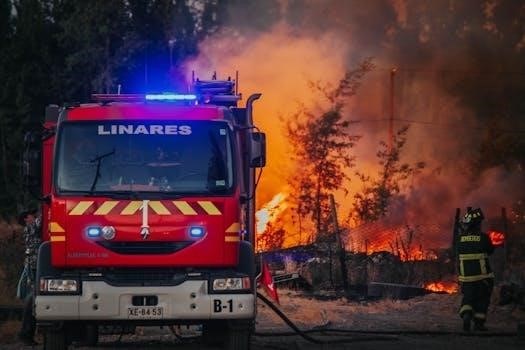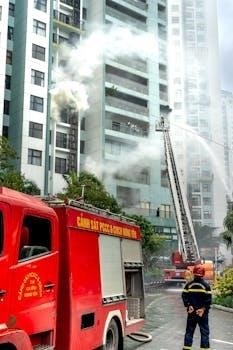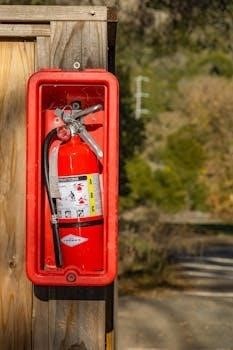Understanding Parallel Lines
Parallel lines are defined as lines that never intersect‚ maintaining a constant distance apart. They run in the same direction and share the same slope. Identifying these lines is key to geometry and understanding spatial relationships.
Definition of Parallel Lines
Parallel lines are a fundamental concept in geometry‚ characterized by their unique property of never intersecting‚ regardless of how far they are extended in either direction. This non-intersection is a result of their constant distance from each other and their identical slopes. Essentially‚ parallel lines run alongside each other‚ maintaining a consistent separation throughout their length. Think of railway tracks; they remain equidistant and will never meet. The concept applies not only to straight lines but also to segments of lines. Understanding this definition is crucial for working with various geometrical shapes and solving problems related to spatial relationships. It is important to remember that they must also be on the same plane. Parallel lines are also critical in defining shapes like parallelograms and trapezoids‚ where parallel sides play a key role in their properties. Therefore‚ when analyzing any figure‚ recognizing parallel lines provides a foundational understanding of the spatial arrangement.

Identifying Parallel Lines on a Graph
Identifying parallel lines on a graph involves a careful examination of their slopes. The key characteristic of parallel lines‚ which ensures that they never intersect‚ is that they possess the same slope. This means that for any two lines to be considered parallel‚ their rise over run must be identical. Visually‚ they will appear to travel in the same direction on the graph‚ either both ascending or both descending at the same rate. When given equations of lines‚ converting them to slope-intercept form (y = mx + b) will make it easy to extract their slopes‚ where ‘m’ represents the slope. If the ‘m’ values are the same for two or more lines‚ then those lines are parallel. Conversely‚ if the lines have different slopes‚ they are not parallel. Graphically‚ this means they’ll either intersect or diverge. Therefore‚ analyzing the slope‚ either through direct observation on the graph or by examining the line’s equations‚ is the primary method to determine if lines are parallel.

Understanding Perpendicular Lines
Perpendicular lines are defined as lines that intersect at a right angle‚ specifically a 90-degree angle. This intersection creates a distinct visual relationship and a specific mathematical connection based on their slopes.
Definition of Perpendicular Lines
Perpendicular lines are fundamentally defined by their intersection at a right angle‚ which is precisely 90 degrees. This characteristic angle is crucial in geometry and distinguishes these lines from parallel or intersecting lines with other angles. When two lines meet in such a manner‚ it signifies a specific spatial relationship‚ forming four right angles at their point of intersection. The concept of perpendicularity is not just visual; it also translates into a precise mathematical relationship between the slopes of the lines involved. This relationship is such that the product of the slopes of two perpendicular lines is always -1‚ provided neither line is horizontal or vertical. Understanding this definition is vital for working with geometric figures‚ solving equations‚ and analyzing spatial problems. The perpendicular relationship is a cornerstone in various mathematical and practical applications‚ from construction to design.
Identifying Perpendicular Lines on a Graph
Identifying perpendicular lines on a graph involves looking for lines that intersect at a 90-degree angle. Visually‚ this appears as a perfect ‘L’ shape‚ or an inverted ‘T’ where the lines meet. To confirm perpendicularity beyond visual inspection‚ one can examine the slopes of the lines. If the product of their slopes equals -1‚ then the lines are indeed perpendicular. This mathematical relationship is a reliable test‚ especially when visual assessment is difficult. For instance‚ if one line has a slope of 2‚ a line perpendicular to it would have a slope of -1/2. Remember that vertical and horizontal lines are always perpendicular to each other. A vertical line has an undefined slope‚ while a horizontal line has a slope of zero‚ which fits the perpendicularity rule in a unique way. Understanding these principles allows for accurate identification of perpendicular lines on any graph.

Working with Equations of Parallel and Perpendicular Lines
Understanding equations is key to determining parallel and perpendicular relationships. Parallel lines share the same slope‚ while perpendicular lines have slopes that are negative reciprocals of each other.
Finding Equations of Parallel Lines
To find the equation of a line parallel to a given line‚ the first crucial step is to identify the slope of the original line. Remember‚ parallel lines have the same slope. Once you have this slope‚ you’ll need a point that the new parallel line passes through. Using the point-slope form (y ⸺ y1 = m(x ⎻ x1)) is an efficient method to construct the equation. Here‚ ‘m’ represents the slope‚ and (x1‚ y1) are the coordinates of the point. After substituting these values‚ you can simplify the equation into slope-intercept form (y = mx + b)‚ if preferred‚ where ‘b’ is the y-intercept. This process allows us to easily create lines that will never intersect with the original line and will always maintain a consistent distance. Mastering this skill is essential for solving various geometric problems and is often featured in worksheets on this topic. The ability to find equations of parallel lines is a cornerstone of understanding linear relationships in mathematics.
Finding Equations of Perpendicular Lines
To determine the equation of a line perpendicular to a given line‚ the initial step involves finding the slope of the original line. The crucial distinction here is that perpendicular lines have slopes that are negative reciprocals of each other. This means that if the original line has a slope of ‘m’‚ the perpendicular line will have a slope of ‘-1/m’. Once the new slope is established‚ you will also need a point that the perpendicular line passes through. By using the point-slope form (y ⎻ y1 = m(x ⸺ x1))‚ substituting the new slope and the coordinates of the given point‚ you can create the equation. Then‚ you can transform this into slope-intercept form (y = mx + b) if desired. This method allows us to accurately create lines that intersect at a right angle to the original line. It is a fundamental skill in geometry and a frequent topic on worksheets regarding these concepts. The ability to find the equations of perpendicular lines is key to solving many geometric problems.

Worksheet Exercises
Worksheets provide vital practice. They include problems on identifying parallel and perpendicular lines. Exercises will involve finding slopes and equations. These activities reinforce understanding‚ enhancing geometry skills.
Types of Problems on Parallel and Perpendicular Lines Worksheets
Worksheets on parallel and perpendicular lines feature a variety of problem types designed to solidify understanding. Students will encounter exercises that require them to identify parallel‚ perpendicular‚ and intersecting lines from visual representations‚ such as graphs and diagrams. Another common type involves determining the slopes of lines‚ which is crucial for establishing whether two lines are parallel or perpendicular. Problems often present equations of lines‚ asking students to identify if they are parallel‚ perpendicular‚ or neither‚ based on their slopes. Additionally‚ some exercises may require students to write the equation of a line that is parallel or perpendicular to a given line‚ passing through a specified point. Real-life applications‚ road maps‚ and geometric shapes are sometimes used to provide context to the problems. Worksheets might also include multiple-choice questions and charts that test comprehension. These diverse problem types ensure a thorough understanding of the core concepts related to parallel and perpendicular lines. Finally‚ some problems may present lines and ask students to determine their relationship‚ ensuring comprehension of the concept.
Using Worksheets for Practice
Worksheets provide an excellent platform for practicing concepts related to parallel and perpendicular lines. They offer a structured way to reinforce learning through a variety of exercises. By completing these worksheets‚ students can enhance their ability to identify parallel and perpendicular lines‚ both visually and through equations. Consistent practice helps in memorizing key relationships‚ such as the fact that parallel lines have the same slope‚ and perpendicular lines have negative reciprocal slopes. Worksheets often include answer keys‚ which allow students to self-assess their work and identify areas that require further attention. Regular use of these resources builds confidence and proficiency in handling problems involving lines. Moreover‚ the diverse range of problem types presented in worksheets ensures that students are exposed to different scenarios‚ solidifying their understanding. This active learning approach improves retention and makes the learning experience more engaging. Interactive online worksheets also provide immediate feedback‚ allowing for more efficient learning. By utilizing parallel and perpendicular lines worksheets‚ students can effectively solidify their mastery of these essential geometric concepts.
















